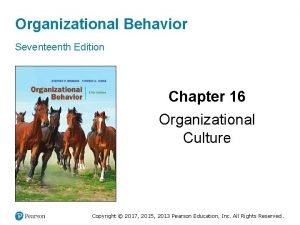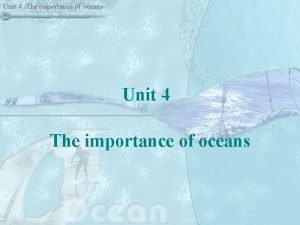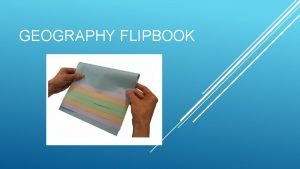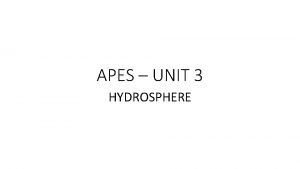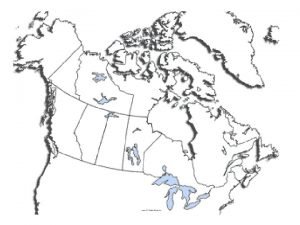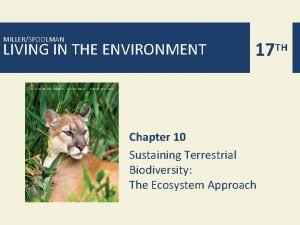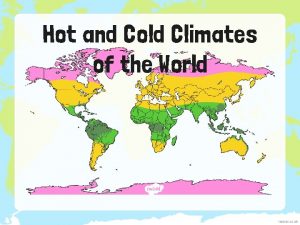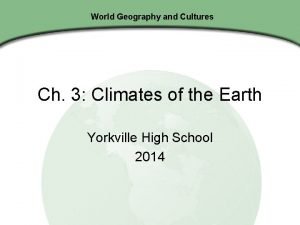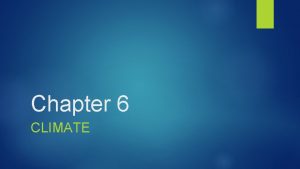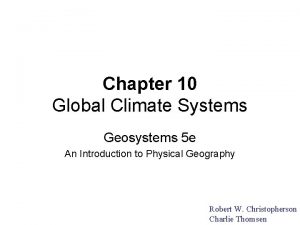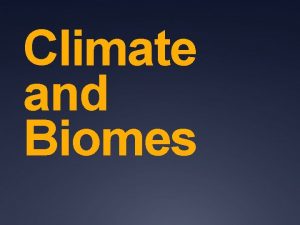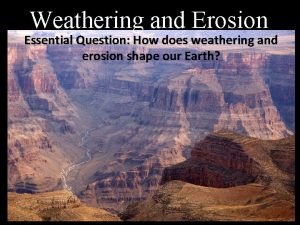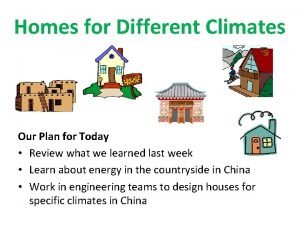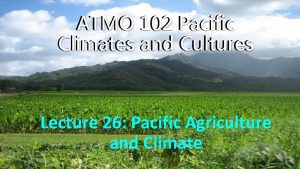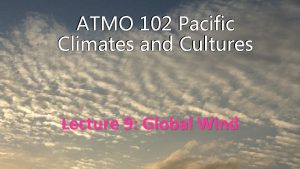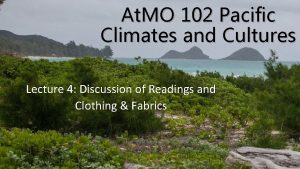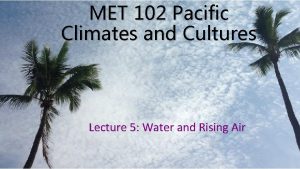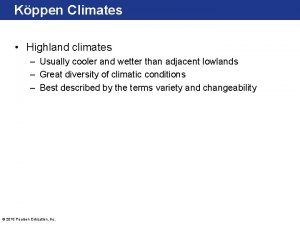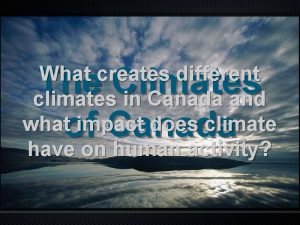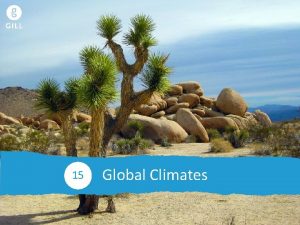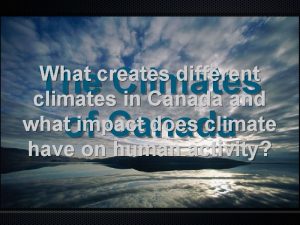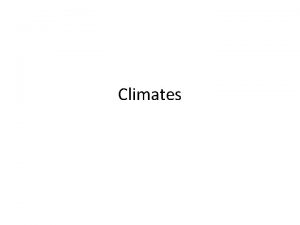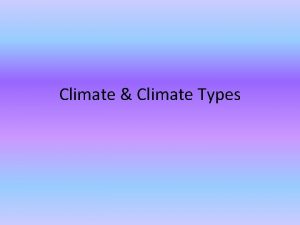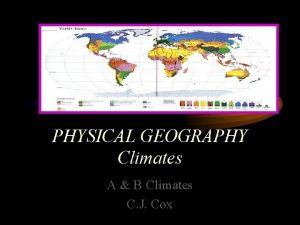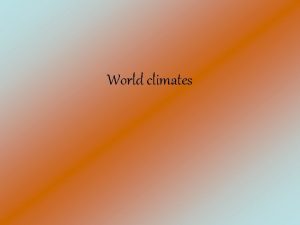ATMO 102 Pacific Climates and Cultures Lecture Ocean






















- Slides: 22

ATMO 102 Pacific Climates and Cultures Lecture: Ocean Currents and Waves

Ocean Water Properties • How they impact ocean currents • Temperature – remember heat rises! • Salinity – remember salty water sinks! • Density – a function of temperature and salinity

Primary Ocean Current Forcing • These Start the Water MOVING: • Sun/solar heating - causes water to expand move • Winds - push the water; winds blowing for 10 hrs across ocean will cause the surface water to flow @ ~2% wind speed; wind has the greatest effect on surface currents • Gravity - pull water downhill or pile against the pressure gradient (high/low); influences tides • Coriolis Force/Effect – Rotational effect, pulling to the right in the Northern Hemisphere and to the left in the Southern Hemisphere

Surface Currents • Surface current – with surface circulation is less dense and influenced by winds 1. Warm surface currents: wind and Earth’s rotation 2. Cold surface currents: flow towards the equator 3. Upwelling current: cold, nutrient rich; result of wind 4. Western Boundary currents: warm & fast 5. Eastern Boundary currents: broad, slow, cool & shallow, associated with upwelling • Ex: Gulf Stream = surface current that is the upper 20% of the ocean, western boundary current

Deep Ocean Currents • Deep water – cold, dense, salty; move by density forces and gravity; move slower than layers above • Thermohaline Circulation driven by: • differences in the density of the sea water • controlled by temperature (thermal) and salinity (haline). • Ex: Global Conveyer Belt = deep current that is the lower 20% of the ocean; takes 1, 000 years to complete the cycle. • This slow (~0. 1 m/s), but giant circulation has a flow equal to about 100 Amazon Rivers.

• Gyres – large mounds of water; large circular currents in the ocean basin • Ex: South Pacific Gyre = consists of 4 separate currents – S. Equatorial, East Australian Current, Peru Current and the West Wind Drift. Ocean Gyres

WAVES

What is a Wave? • A Wave is a rhythmic movement that carries energy through matter or space. • In oceans, waves move through seawater

Parts of a Wave • Crest – highest point of a wave • Trough – lowest point of a wave • Wave Height – vertical distance between the crest and the trough • Wavelength – horizontal distance between two crests or two

• When a wave passes through the ocean, Wave individual water molecules move up and down but they do not move forward or backward. Movement

Wave Movement • When a wave breaks against the shore, the crest outruns the trough and the crest collapses. • Called a breaker. • In this case, water does move forward and backward. • Waves Break in the Surf Zone

Types of Breakers • Spilling breaker • Top of wave crest ‘spills over’ wave. Energy released gradually across entire surf zone. • Plunging breaker • Crest ‘curls over’ front of wave. Energy dissipates quickly. Common at shorelines with steep slopes • Surging breaker • Never breaks as it never attains critical wave steepness. Common along upwardly sloping beach faces or seawalls. Energy released seaward.

Idealized Wave Spectrum • Waves come in different shapes and sizes with differences in wave height and wave period.

Wind Generated Waves • Most of the waves present on the ocean’s surface are wind-generated waves. • Size and type of wind-generated waves are controlled by: • • CALM WIND wind velocity wind duration Fetch (distance over the sea surface) original state of the sea surface. • As wind velocity increases wavelength, period and height increase, but only if wind duration and fetch are sufficient. STORMY WIND

Fetch • Fetch is the area of contact between the wind and the water and is where wind-generated waves begin. • Seas is the term applied to the sea state of the fetch when there is a chaotic jumble of new waves. • Waves continue to grow until the sea is fully developed or becomes limited by fetch restriction or wind duration.

Fetch and Wave Shape Chaotic seas inside fetch area. Swells: wave type found outside the fetch.

Tides • The rise and fall in sea level is called a tide. • Caused by a giant wave. • Tidal range is the difference in ocean level between high-tide and lowtide • One low-tide/high-tide cycle takes about 12 hrs and 25 min.

Tides • Two big bulges of water form on the Earth: • one directly under the moon • another on the exact opposite side • As the Earth spins, the bulges follow the moon.

Tides • Spring Tides • Earth, Moon, and Sun are lined up • High Tides are higher and Low Tides are lower than normal • Neap Tides • Earth, Moon, and Sun form right angles • High Tides are lower and Low Tides are higher than normal

• Semidiurnal • two high and two low tides of approximately equal size every lunar day. • Diurnal • one high and one low tide every lunar day. • Mixed Semidiurnal • two high and two low tides of different size every lunar day. Global Tidal Patterns

Hanauma Bay Predicted Tides • What type of tidal cycle do you see here? Mixed Semi-diurnal? • The combination of diurnal, semi-diurnal and fortnightly cycles dominates variations in sea level throughout the islands.

Hawaii Island – Tidal Currents • Tidal currents result from tidal variations of sea level, and near shore are often stronger than the large scale circulation.
 Organizational behavior
Organizational behavior Importance of oceans
Importance of oceans Mississippi river
Mississippi river Pacific ocean facts
Pacific ocean facts Environmental issues cloze notes 1
Environmental issues cloze notes 1 Chapter 15 ocean water and ocean life
Chapter 15 ocean water and ocean life 01:640:244 lecture notes - lecture 15: plat, idah, farad
01:640:244 lecture notes - lecture 15: plat, idah, farad Unfenced grasslands in tropical and temperate climates
Unfenced grasslands in tropical and temperate climates Hot and cold world map
Hot and cold world map Divergent and convergent plate boundaries
Divergent and convergent plate boundaries Ocean ocean convergent boundary
Ocean ocean convergent boundary Convergent plate boundaries
Convergent plate boundaries Ocean ocean convergent boundary
Ocean ocean convergent boundary Scrat's continental crack-up
Scrat's continental crack-up Convergent oceanic oceanic plate boundary
Convergent oceanic oceanic plate boundary Blue og red ocean
Blue og red ocean Chapter 3 climates of the earth answers
Chapter 3 climates of the earth answers What impact does the ocean have on climate brainpop
What impact does the ocean have on climate brainpop Lesson outline lesson 1 climates of earth answers key
Lesson outline lesson 1 climates of earth answers key Explain how köppen’s climate system classified climates.
Explain how köppen’s climate system classified climates. Different climates around the world
Different climates around the world Weathering
Weathering Houses in different climates
Houses in different climates
